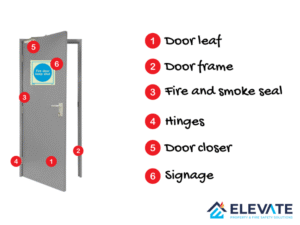Protecting Lives and Property in High-Density Living Spaces
Fire doors are vital safety features in student accommodation. They prevent the spread of fire and smoke, providing critical time for occupants to evacuate and for emergency services to respond. Their proper maintenance and functionality are essential to ensuring the safety of residents.
Key Functions of Fire Doors
- Containment: Fire doors are designed to compartmentalize fires, limiting their spread to other areas.
- Smoke Control: Prevent toxic smoke from infiltrating escape routes like hallways and stairwells.
- Evacuation Support: Buy valuable time for occupants to safely exit the building.
- Structural Integrity: Protect critical parts of the building, reducing fire damage and increasing the chance of recovery.
Fire Doors in Student Accommodation
In high-density living environments like student housing, fire doors serve as a first line of defense:
- Room Protection: Fire doors in dormitory rooms shield individual living spaces from fire and smoke.
- Escape Routes: Doors in hallways and staircases ensure safe evacuation paths remain unobstructed.
- Shared Areas: Kitchens, lounges, and other communal areas are equipped with fire doors to contain potential fire sources.
Characteristics of an Effective Fire Door
- Fire-Resistant Materials: Built to withstand fire for a specified period, typically 30 to 60 minutes.
- Self-Closing Mechanism: Ensures the door closes fully after use, maintaining its protective barrier.
- Intact Seals and Gaps: Smoke seals and intumescent strips expand under heat, blocking fire and smoke.
- Proper Signage: Clear instructions such as “Fire Door – Keep Shut.”
The Role of Fire Doors During a Fire
- Delays Fire Spread: Containing the fire to its origin allows residents more time to evacuate.
- Reduces Smoke Exposure: Prevents the quick spread of harmful smoke, a leading cause of fire-related injuries.
- Assists Emergency Services: By compartmentalizing the fire, it makes the work of firefighters safer and more efficient.
Why Maintenance Matters
- Regular Inspections: Identify and resolve issues like damage, faulty hinges, or non-functional self-closing mechanisms.
- Training for Residents: Educate students about the importance of keeping fire doors unobstructed and properly shut.
- Compliance with Regulations: Ensure fire doors meet local and national fire safety standards.
Tips for Student Accommodations
- Conduct monthly fire door inspections and address faults immediately.
- Train residents and staff on fire safety procedures, emphasizing fire door usage.
- Display clear fire door signage throughout the property.
In conclusion, Effective fire doors are indispensable for ensuring the safety of students in high-density accommodations. By containing fires, controlling smoke, and maintaining structural integrity, fire doors provide critical protection to residents and properties. However, their effectiveness relies on regular maintenance, adherence to safety standards, and active participation from students and staff. Prioritizing the functionality and proper use of fire doors is not just a regulatory requirement—it is a responsibility that saves lives.
Take proactive steps to enhance fire safety in student accommodations today:
- Schedule Routine Inspections: Ensure all fire doors are functioning correctly and compliant with safety regulations.
- Educate Residents: Provide clear guidance on the importance of keeping fire doors unobstructed and properly closed.
- Commit to Compliance: Stay up-to-date with local fire safety standards to maintain a safe living environment.





